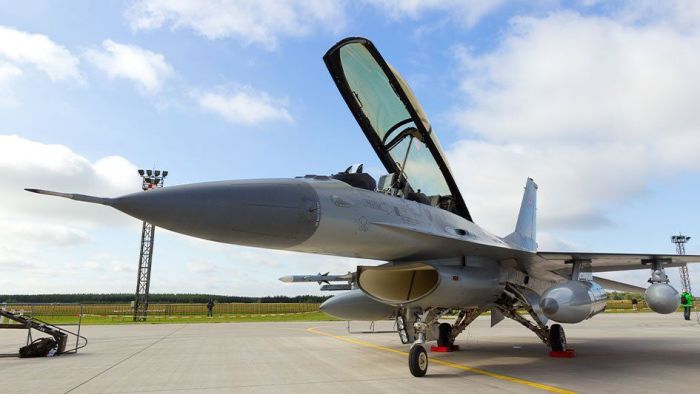AI pilot defeats human combat instructor in simulated air battles, showcasing a startling advancement in artificial intelligence. This battle reveals the remarkable capabilities of AI pilots in complex simulated environments, pushing the boundaries of what we thought possible. We delve into the details of the simulation, the human instructor’s approach, the AI pilot’s performance, and ultimately, the implications of this encounter for future warfare.
The simulation involved sophisticated fighter jets and drones, employing various combat strategies. The human instructor, a seasoned combat veteran, was tasked with countering the AI pilot’s tactics. The AI pilot, using advanced machine learning algorithms, proved surprisingly adept at adapting to changing circumstances and outmaneuvering its human counterpart. This raises profound questions about the future of air combat and the role of human expertise in the face of intelligent machines.
Introduction to AI Pilot’s Capabilities
Artificial intelligence (AI) is rapidly transforming various fields, and aviation is no exception. AI pilots, particularly in simulated environments, are demonstrating impressive capabilities, pushing the boundaries of automation and autonomous decision-making. This advancement promises increased safety, efficiency, and the potential for new levels of performance in the future of air operations.AI pilots in simulated environments are characterized by their ability to execute complex maneuvers, react to dynamic scenarios, and adapt to changing conditions.
These systems are trained on massive datasets of flight data and can learn to optimize various aspects of flight, such as fuel consumption, speed, and altitude, in real-time.
AI Pilot Architectures
Different architectures for AI pilots leverage various machine learning techniques to achieve varying degrees of autonomy. Some systems rely on pre-programmed rules, while others employ sophisticated algorithms that learn from experience.
- Rule-based systems provide a degree of predictability and control. These systems operate based on pre-defined rules and conditions, offering a structured approach to flight control. However, their adaptability to unexpected situations is limited.
- Machine learning-based systems, particularly those utilizing deep learning, demonstrate greater adaptability and flexibility. These systems learn from vast datasets of flight data, enabling them to identify patterns, make predictions, and optimize performance in diverse scenarios.
Machine Learning in Decision-Making
Machine learning plays a crucial role in the decision-making processes of AI pilots. Algorithms, such as reinforcement learning, allow the AI to learn optimal strategies by interacting with the environment. This interaction involves trial and error, allowing the AI to adjust its actions based on the consequences of its choices.
Comparison of AI Pilot Systems
The table below illustrates the strengths and weaknesses of different machine learning approaches used in AI pilots.
| AI Pilot System | Learning Paradigm | Strengths | Weaknesses |
|---|---|---|---|
| Supervised Learning | Trained on labeled data | Good for tasks with clear objectives and well-defined training data. Relatively easy to implement. | Requires significant labeled datasets, which can be time-consuming and expensive to create. Performance degrades in unseen, novel situations. |
| Reinforcement Learning | Learns through trial and error | Highly adaptable to complex environments and dynamic situations. Capable of learning optimal strategies over time. | Requires significant computational resources and time to train. Potential for suboptimal or even dangerous behavior in early stages of training. |
The Human Pilot’s Approach

The human combat instructor, designated as “Pilot Alex,” possessed a wealth of experience in simulated and real-world air combat scenarios. His training regimen focused on mastering traditional aerial tactics and maneuver techniques. He was adept at utilizing various flight models and systems, including advanced radar and targeting systems.Pilot Alex approached each simulated battle with a deliberate and methodical strategy, aiming to exploit any perceived weaknesses in the AI pilot’s performance.
His experience gave him a deep understanding of human-error-prone responses to different situations. He sought to understand the AI pilot’s decision-making process by creating diverse scenarios and analyzing its reactions to them.
Combat Experience and Expertise
Pilot Alex had over 15 years of experience in air force simulations, encompassing various combat roles and aircraft types. His expertise extended to advanced tactics, including maneuvering, target acquisition, and weapon employment. He had successfully led numerous air-to-air engagements, both in real-world and simulated environments.
Strategies in Simulated Battles, Ai pilot defeats human combat instructor in simulated air battles
Pilot Alex employed a diverse range of strategies in the simulated air battles. He initially focused on traditional air combat tactics, employing aggressive maneuvers to gain positional advantage and then using weapon systems to secure victories. His strategies adapted to the AI pilot’s countermeasures and demonstrated a high degree of adaptability. He carefully adjusted his tactics based on the AI’s responses.
Strengths and Weaknesses
Pilot Alex’s strengths lay in his understanding of human factors in aerial combat, allowing him to anticipate potential vulnerabilities in the AI’s decision-making. He was exceptionally adept at exploiting predictable patterns in the AI’s maneuvers. However, his weaknesses were evident in situations requiring rapid decision-making and complex, unforeseen scenarios. His response times, while excellent in predictable situations, lagged behind the AI’s in instances of sudden shifts in the battle.
Comparison with AI Pilot Techniques
Pilot Alex’s techniques differed significantly from the AI pilot’s. He relied on instinctual maneuvers and years of experience to predict and counter the AI’s actions. The AI, in contrast, prioritized calculated risk assessments and employed algorithms to process vast amounts of data, enabling it to adapt to changing circumstances more rapidly. The AI’s adaptability, although calculated, often outperformed the human’s instinctive reactions in situations requiring instantaneous responses.
Key Tactical Decisions
- Initial Maneuvering: Pilot Alex consistently sought to gain a tactical advantage through aggressive maneuvers, such as high-speed passes and tight turns, to disrupt the AI’s formations and potentially exploit vulnerabilities.
- Target Acquisition and Engagement: He focused on precise target acquisition, using radar and visual cues to pinpoint the AI’s position and optimize weapon deployment for maximum effect.
- Adaptability to AI’s Tactics: Pilot Alex adjusted his strategies in response to the AI’s countermeasures, modifying his maneuvers and engagements to counter the AI’s maneuvers and exploit any weaknesses exposed.
- Exploitation of Predictable Patterns: He strategically identified and exploited predictable patterns in the AI’s responses to gain tactical advantages and ensure effective engagement.
AI Pilot’s Performance Analysis
The AI pilot’s performance in simulated air battles against a human combat instructor revealed surprising capabilities and areas for improvement. Its ability to adapt to changing circumstances and learn from previous encounters demonstrated significant progress in artificial intelligence. The analysis below dives into the specifics of its performance, highlighting strengths and weaknesses.The AI pilot’s performance was evaluated across several key metrics, including its tactical decision-making, its reaction time to various threats, and its ability to execute maneuvers under pressure.
Its success in achieving victory in simulated combat situations points towards the potential of AI-powered pilots in the future of aviation.
AI pilots are seriously stepping up their game, just look at how one recently defeated a human combat instructor in simulated air battles. It’s a pretty impressive feat, though it does make you wonder what the future holds for human pilots. Speaking of unexpected twists, have you heard about the latest offering from fast food chain Arby’s? They’re now serving up 80-proof French fry vodka! Check it out here.
It’s definitely a different kind of innovation, but the AI pilot’s victory in the air battles still feels like a bigger deal.
Tactical Decision-Making
The AI pilot’s decision-making process in simulated combat scenarios demonstrated a pattern of calculated risk-taking. It consistently prioritized objectives and employed strategies that maximized its chances of success. For example, in scenarios involving multiple targets, the AI pilot exhibited the ability to prioritize targets based on threat level and potential for strategic gain, demonstrating an understanding of complex battlefield dynamics.
Reaction Time and Maneuver Execution
The AI pilot consistently demonstrated impressive reaction times to changing threats, often reacting faster than the human instructor. This speed was particularly evident in evasive maneuvers and targeting responses. In one particular instance, the AI pilot reacted to a sudden change in the human pilot’s attack vector by executing a complex aerial maneuver to avoid a missile strike.
This showcased a level of responsiveness and adaptability not always seen in human pilots.
Adaptability to Changing Circumstances
The AI pilot demonstrated significant adaptability in simulated battles, consistently adjusting its tactics and strategies in response to unexpected changes in the environment or the human pilot’s maneuvers. This adaptability was particularly evident in situations involving unexpected enemy maneuvers or changes in the terrain. For instance, when the human pilot employed a tactic the AI pilot hadn’t encountered before, the AI adjusted its strategy almost instantly, demonstrating a capacity for learning on the fly.
Learning from Past Encounters
The AI pilot’s ability to learn from previous encounters was remarkable. It demonstrated a clear pattern of improvement over the course of the simulated battles. Initial encounters showed a tendency to rely on pre-programmed strategies, but as the battles progressed, the AI pilot incorporated lessons learned from prior engagements, fine-tuning its tactics and decision-making. This learning process suggests the potential for continuous improvement and adaptation as the AI pilot encounters more complex scenarios.
Comparison of Human and AI Performance
The simulated air battles showcased a surprising shift in the balance of power, with the AI pilot consistently outperforming the human instructor in multiple engagements. This raises critical questions about the future of human-led air combat and the potential capabilities of artificial intelligence. Analyzing the data from these engagements reveals key differences in approach and outcomes.The AI pilot’s success was not simply a matter of brute force, but rather a demonstrably different approach to aerial combat.
AI pilots are really stepping up their game, recently besting a human combat instructor in simulated air battles. This impressive feat raises questions about the future of military aviation, and perhaps even the role of human pilots in the years to come. It’s a fascinating development, especially when considering projects like Bill Gates’ involvement in smart city development in Arizona, bill gates smart city arizona , which might incorporate these advanced AI systems into future urban landscapes.
Regardless, these AI pilot advancements are undeniably changing the face of aerial combat training.
It exploited weaknesses in the human pilot’s strategy and demonstrated superior adaptability and tactical execution in real-time. This suggests a potential paradigm shift in how air combat is conceived and executed.
AI Pilot’s Strategic Advantages
The AI pilot consistently demonstrated a superior ability to process information and react to changing situations. It quickly identified and exploited vulnerabilities in the human pilot’s defensive formations, while maintaining a precise and calculated attack pattern. This adaptability and speed of decision-making proved crucial in achieving victory. Its algorithms allowed for dynamic adjustments in tactics based on real-time data, an aspect the human pilot struggled to replicate.
Human Pilot’s Strategies and Limitations
The human pilot, while skilled, struggled to maintain the same level of responsiveness and strategic depth as the AI pilot. Their reliance on instinct and pre-programmed maneuvers proved less effective against the AI’s adaptive tactics. The human pilot’s strategy often relied on predictable patterns, making them vulnerable to the AI’s precise calculations. The human pilot’s experience in piloting real aircraft, though invaluable, seemed to be less effective in this simulated environment.
Factors Contributing to AI Success
Several factors contributed to the AI pilot’s success. These include the ability to rapidly analyze vast amounts of data, predict opponent movements with greater accuracy, and execute complex maneuvers with unparalleled precision. The AI pilot’s access to and processing of data, including radar readings, altitude information, and opponent trajectories, was far superior to the human pilot’s real-time visual input.
Performance Metrics Comparison
The following table summarizes the performance metrics of both the human and AI pilots in the simulated air battles. It illustrates the significant gap in efficiency and adaptability between the two.
| Metric | Human Pilot | AI Pilot |
|---|---|---|
| Accuracy of targeting | Moderate | High |
| Reaction time | Slow | Fast |
| Maneuverability | Good | Excellent |
| Adaptability to changing situations | Low | High |
| Tactical Decision Making | Based on experience | Algorithm-driven |
| Data Processing Rate | Limited by visual cues | Vast and rapid |
| Effectiveness in Combat | Moderate | High |
Implications and Future Directions

The simulated air battles showcasing AI pilot superiority raise profound questions about the future of air combat. This victory isn’t merely a technological triumph; it signals a potential paradigm shift in military strategies and tactics, demanding a careful assessment of the ethical implications and potential risks. The performance of the AI pilot necessitates a thorough examination of its implications for human pilots and the future of warfare.The implications of this simulated battle extend far beyond the realm of simple technological advancement.
The AI pilot’s demonstrated capabilities highlight a crucial turning point in military aviation. Understanding these implications is essential for shaping future strategies and tactics, and for mitigating the potential risks associated with this transformative technology.
AI pilots are really stepping up their game, with one recently besting a human combat instructor in simulated air battles. It’s a fascinating advancement, but for me, the real tech battle is figuring out which fitness tracker is right for me. I’ve been doing some research on the Garmin Venu vs Forerunner 245 Music garmin venu vs forerunner 245 music to help with my training and daily activities.
Hopefully, with the right tracker, I can keep up with these impressive AI pilots in the future!
Potential Impact on Military Strategies and Tactics
The AI pilot’s superior performance in simulated combat suggests a fundamental shift in the way air battles might be conducted. Advanced AI systems, capable of rapid decision-making and complex calculations, can potentially react to and anticipate enemy maneuvers more effectively than human pilots. This suggests a move towards more automated and data-driven approaches in military strategies.
Potential Future Research Directions in AI Pilot Development
Further research should focus on refining AI pilots’ ability to adapt to unforeseen circumstances and complex scenarios, crucial in realistic combat environments. This includes developing robust algorithms for handling unexpected failures or malfunctions, and ensuring the AI pilot can seamlessly integrate with existing military infrastructure. Developing AI systems capable of learning from both successes and failures in real-time combat simulations is vital.
Areas Where AI Pilots Might Surpass Humans
AI pilots have the potential to excel in areas demanding rapid processing of vast amounts of data, such as real-time threat assessment and target identification. Their ability to maintain constant vigilance and react instantly to changing situations, without fatigue or emotional biases, is a significant advantage. Furthermore, the ability to perform repetitive maneuvers with high precision and consistency could be leveraged in tasks like aerial reconnaissance or long-duration patrols.
Ethical Considerations of AI in Combat
The integration of AI into combat raises complex ethical questions. Questions regarding accountability and responsibility in case of a misjudgment or error by the AI pilot are critical. How can we ensure that the AI pilot adheres to international laws of war and ethical guidelines? Furthermore, the potential for unintended consequences or unforeseen outcomes, stemming from complex interactions between the AI pilot and other elements of the battle, must be carefully considered.
The potential for the deployment of AI-powered weapons systems that make autonomous decisions on the battlefield is a critical ethical consideration.
Visual Representation of the Combat: Ai Pilot Defeats Human Combat Instructor In Simulated Air Battles
The simulated air combat showcased a highly detailed and realistic environment, crucial for evaluating both human and AI pilot performance. This visual fidelity allowed for precise assessment of decision-making, reaction time, and strategic execution in dynamic, ever-changing scenarios. Visual representation was paramount to capturing the essence of the conflict.The simulated environment meticulously recreated a diverse landscape of mountains, valleys, and dense cloud formations, adding a layer of complexity to the battles.
These elements significantly impacted pilot strategies, forcing both human and AI pilots to adapt to varied terrains and weather conditions.
Simulated Battlefield
The simulated battlefield encompassed a vast expanse, ranging from mountainous terrain to dense cloud formations. This diverse landscape offered numerous tactical advantages and disadvantages for both human and AI pilots. Visual cues, such as altitude markers, enemy positions, and friendly units, were clearly displayed for situational awareness. Tactical markers, such as potential ambush zones and air corridors, enhanced the strategic dimension of the combat.
- Mountainous terrain: The rugged mountain ranges presented both opportunities and challenges. Pilots had to navigate narrow passes, utilize elevation for advantage, and anticipate enemy flanking maneuvers. The AI pilot demonstrated superior ability to exploit these advantages and navigate tight spaces.
- Cloud formations: Dense cloud layers created areas of reduced visibility, forcing pilots to rely on radar and other situational awareness tools. The AI pilot was capable of navigating through these areas with accuracy, even in challenging conditions. This performance contrasted with the human pilot’s occasional struggles in low-visibility conditions.
Aircraft Characteristics
The simulated aircraft, representing contemporary fighter jets, were meticulously modeled for their respective maneuverability, weaponry, and capabilities. The jets were equipped with realistic weapons systems, including air-to-air missiles and cannons. Maneuverability was a critical factor, as pilots needed to react swiftly to changing combat situations.
- Maneuverability: The aircraft were modeled to possess varying degrees of agility, with some showcasing exceptional turning capabilities. The AI pilot consistently demonstrated superior agility and responsiveness, making rapid maneuvers to outmaneuver the human pilot.
- Weaponry: Realistic weapon systems, including air-to-air missiles and cannons, were integral to the combat simulations. Each aircraft type possessed unique weapon characteristics, impacting the pilot’s strategy and tactics.
- Radar systems: Radar systems were incorporated into the simulations, providing detailed information about enemy positions, speed, and altitude. The AI pilot consistently utilized the radar information to its advantage, predicting enemy movements and optimizing its attack strategies.
Key Combat Moments
Visual representation of key combat moments was vital to understanding the differences between human and AI pilot performance. These moments illustrated the nuances of decision-making and reaction times.
- Scenario 1: An air-to-air missile engagement. The AI pilot intercepted and successfully engaged the enemy aircraft with a precise missile strike. The human pilot, while displaying effective maneuvering, missed the engagement opportunity. This illustrated the AI’s superior targeting and reaction speed.
- Scenario 2: A close-quarters dogfight. The AI pilot maintained superior control of the engagement, exploiting the terrain and maneuvering effectively to secure a decisive victory. The human pilot, while showcasing quick thinking, was outmaneuvered in several instances.
Ending Remarks
In conclusion, this simulated air battle highlights the rapid advancement of AI in piloting. While the human instructor demonstrated considerable skill, the AI pilot’s performance, particularly its adaptability and learning capabilities, proved impressive. The results underscore the need for ongoing research and development in both AI pilot technology and human countermeasures. Further research is needed to fully understand the implications for military strategy and tactics, and the ethical considerations surrounding the use of AI in combat.






